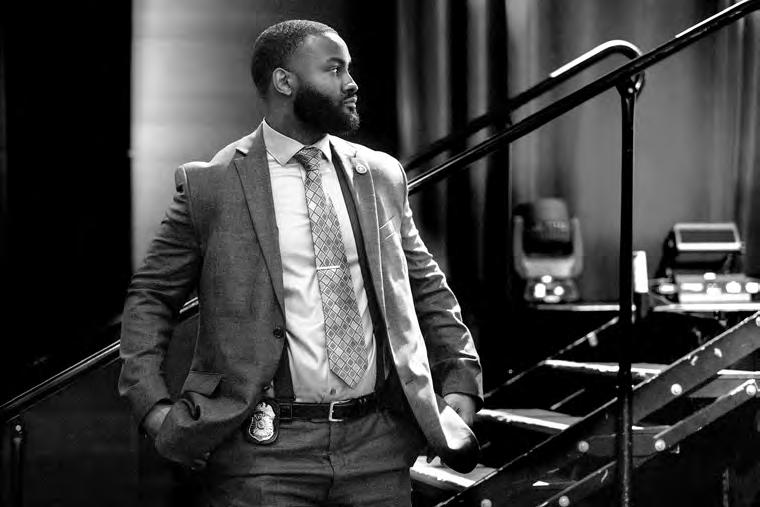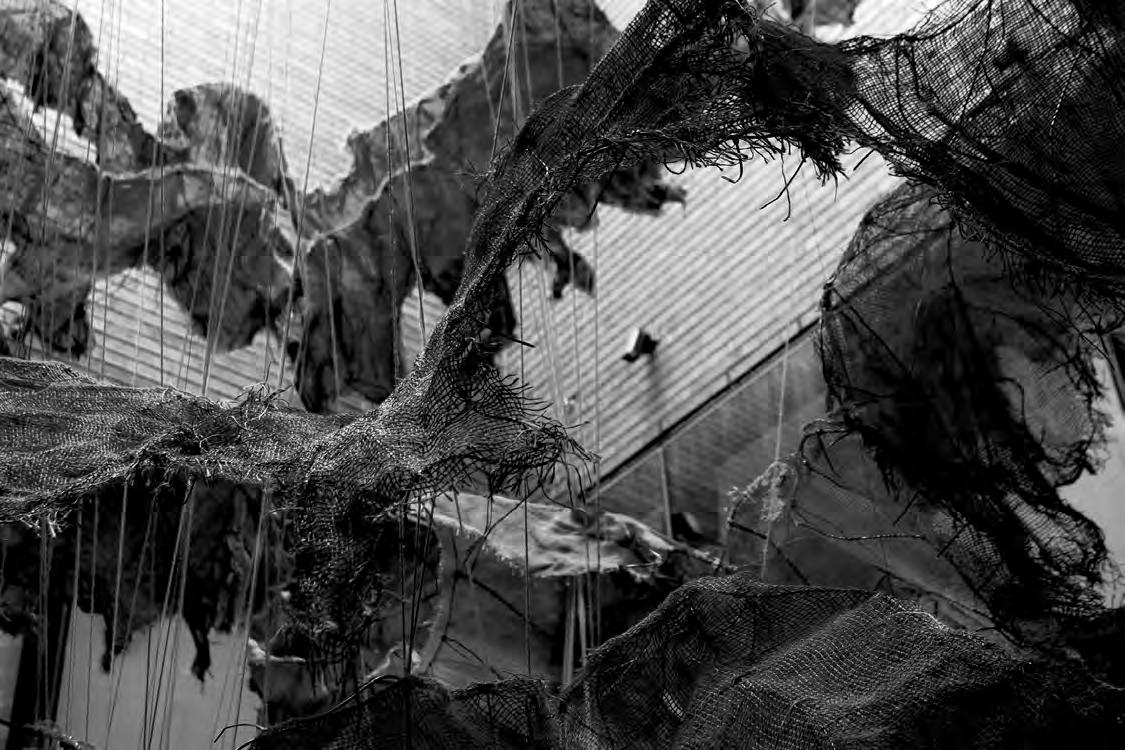REPUBLICAN PRESIDENTIAL CANDIDATES TAKE THE STAGE
This year’s Lincoln Dinner hosted 13 Republican presidential candidates, each taking turns to speak to a sold-out Des Moines audience.

The Daily Iowan
Edited by Will Shortz No. 0628
STAFF
Publisher | 335-5788
Jason Brummond
Summer Editors | 335-6030
Parker Jones, Alejandro Rojas
News Editor
Ellie Heeren
Visuals Editor
Cody Blissett
Arts Editor
Avi Lapchick
Opinions Editor
Evan Weidl
Sports Editor
Kenna Roering
Design Editor
Marandah Mangra-Dutcher
Digital Editor

Maddie Willis
BUSINESS STAFF
Business Manager | 335-5786
Debra Plath
Advertising Director/ Circulation Manager | 335-5784
Juli Krause
Production Manager
Heidi Owen
BREAKING NEWS
Phone: (319) 335-6030 | Email: daily-iowan@uiowa.edu
CORRECTIONS
Call: 335-6030
Policy: The Daily Iowan strives for accuracy and fairness in the reporting of news. If a report is wrong or misleading, a request for a correction or a clarification may be made.
PUBLISHING INFO
The Daily Iowan (USPS 143.360) is published by Student Publications Inc., E131 Adler Journalism Building, Iowa City, Iowa 52242-2004. Periodiof March 2, 1879.
ACROSS
1 Sport of climbing mountains
9 SAG-___ (broadcast workers’ union)
14 See 3-Down
15 See 10-Down
16 Providers of in-flight entertainment?
17 Cold sauces
18 Parlor decoration, for short 19 Bit of braggadocio
21 Target of CRISPR editing
22 Fabric derived from wood pulp 25 Former Mideast alliance, in brief
52 Onetime boxy Toyota
54 Asian peninsula: Abbr.
57 Cell with pseudopods
59 See 44-Down
62 See 58-Down
63 Currency zone whose members include Finland and Malta
64 Struck, biblically
65 Advice on a fashion blog
1 Pit-___
2 Organa who’s also a Skywalker
3 With 14-Across, first (and last) gift of a seasonal song
4 Part of a return address?
5 To the ___ power
6 Classic collection from the magazines Super Science Stories and Astounding Science Fiction
7 Attach, as a button
8 Feature of the Painted Desert
9 Yellowfin tuna
10 With 15-Across, cause of some hoarseness
11 Flat sign, maybe
12 Comes down
13 Completely disoriented
15 Straw mats
20 From Lausanne, par exemple
23 Finally 24 “Woo-hoo!”
26 Apt name for an angler
28 Air quality concern
29 ___ Alto
30 With 38-Across, hidden traitor

31 Largest city in New Jersey
33 Like a free ride when you’ve already paid, per a 1996 hit

34 Little attire
35 With 42-Across, source of restless anticipation

36 Wall St. landmark
38 Tries to get hold of
41 “Dude”
42 Seating on Sunday
44 With 59-Across, harbinger of danger
45 Cleans, as a deck
46 Stereotypical shout-out on a jumbotron
47 Prefix meaning budget-friendly 49 Recede
51 Superman, most of the time 53 Clinches
55 R.E.M.’s “The ___ Love”
56 Bring in the sheaves, say
58 With 62-Across, persistent little obsession
60 Reaction to a funny GIF
61 Endeavour astronaut Jemison
Candidates focus on topics including education, Biden
The 13 candidates were given 10 minutes each to speak, with most focusing on issues of education, border security, the economy, and Biden.
Alejandro Rojas Summer EditorOn one of the hottest days of the summer, dozens upon dozens of people dressed all in black scurried around a large banquet hall preparing tables. Placing glasses of water, plates of decadent food, shining cutlery, and decorative candles, the room soon took shape. At first glance, it appeared to be an ordinary formal dinner event. But taking a look at the main stage at the back of the room in the Iowa Events Center in Des Moines, Iowa, revealed the true occasion: the Iowa Republican Party’s 2023 Lincoln Dinner.
The dinner is a yearly event held by the Republican Party in Iowa, with this year’s edition on July 28 featuring a total of 13 Republican presidential candidates:

• Former President Donald Trump
• Former Vice President Mike Pence
• Florida Gov. Ron DeSantis
• South Carolina Sen. Tim Scott
• Former Arkansas Gov. Asa Hutchinson
• North Dakota Gov. Doug Burgum
• Former U.N. Ambassador Nikki Haley
• Michigan businessman Perry Johnson
• Former Texas Sen. Will Hurd
• Mayor of Miami, Florida, Francis Suarez
• Texas businessman Ryan Binkley
• Political commentator and talk-show host Larry Elder
• Entrepreneur Vivek Ramaswamy
Tickets for the event were sold out, with roughly 1,000 people in attendance. Ticket packages for the event ranged in price from $10,000 for a table of 10 with “premier” seating and tickets for the reception, to $1,500 for just a table of 10, according to the Iowa GOP’s website.
The event was one of many campaign stops for the candidates as the Iowa Republican Party gears up for its caucus in January, still
serving as the GOP’s first caucus in the nation. The lineup was largely the same as the “Roast and Ride” event hosted on June 3, with the only additions this time being Trump, Burgum, Hurd, Suarez, and Binkley.
The dinner was kicked off by a short introduction, followed by a prayer, the pledge of allegiance, and a live rendition of the “Star Spangled Banner.” Rounding off the introduction was a speech
by Iowa GOP Chairman Jeff Kaufmann.
Kaufmann began by referencing the controversial new song “Try that in a Small Town” by country musician Jason Aldean, that is alleged to contain racist language and “dog whistles,” or coded language that one specific group might understand.
“In Iowa small towns we honor tradition. In Iowa small towns we stand up for the anthem. In Iowa
small towns, we protect women’s sports. In Iowa small towns we believe in the power of the people to make decisions with their own money,” Kaufmann said. Following him was a speech from Iowa Gov. Kim Reynolds, who emphasized the importance of Iowa maintaining its first-in-thenation status. She also highlighted the recent work and legislation the
LINCOLN
Continued from 3
GOP-controlled House and Senate have passed this year, such as the law passed in April that restructured the Iowa’s government.
After Reynolds’ speech, the 13 candidates each took turns speaking on stage.
Border security, COVID-19, education, and the economy main talking points
Each of the 13 candidates took the stage while the song “Only in America” by Brooks & Dunn played. Most of the 13 speeches addressed concerns about security at the southern border with Mexico, lockdowns from the COVID-19 pandemic, issues sur-
rounding education, and claims of a staggering or even failing economy, despite recent data which shows that the U.S. GDP has slightly increased.
Regarding education, some candidates like Haley called for parents to have a choice in sending their students to public or private schools across the country, and to ensure parents are more aware and involved with the curriculum being taught in schools.
“When it comes to education, let’s do what your great Gov. Kim Reynolds did. Let’s make sure our kids can read by the third grade, let’s have complete transparency in the classroom, and let parents decide where their kids should go to school,” Haley said.
Haley’s comments came in reference to the education bills passed by Reynolds in June that changed the curriculum and gave parents more freedom to change their child’s school.
Education was also a main talking point for DeSantis, who also touted his record during the pandemic, which included keeping schools and businesses open, and not requiring face coverings.
“Those [pandemic] policies were disruptive for this country,” DeSantis said. “They hurt people they hurt our economy, and we still haven’t fully recovered from it.”
Attacks on Biden
The other main theme across
all the speeches was renewed calls to action to vote Biden out of the White House in 2024, with many also calling into question his competency to do so. This included a remark from Haley, who suggested implementing a mental competency test.
“We got to have mental competency test for anyone over the age of 70,” Haley said. “That’s not being disrespectful. These are people who are making decisions on our national security decisions on our economic tough test.”
Possible questions, Haley suggested, could include asking a person how many grandchildren they have, a jab at Biden who last week publicly acknowledged a seventh granddaughter for the first time.
But it also comes after House Minority leader Mitch McConnell froze while at a press conference last week, raising health concerns about the GOP’s top leader.
Other candidates chose to take a different route, instead choosing to simply attack Biden’s decisions and administration, such
“America needs a 180-degree change from the direction where Joe Biden is taking us right now. Joe Biden is wrong on the economy, he’s wrong on energy and he’s wrong on national security, which includes food security and border security,” Burgum said. “To turn this country around, we need someone who understands how to compete and win in a
few moments to walk around the stage and wave to the applauding crowd before his speech.
He began his speech by saying that the state of Iowa had never “had a better friend in the White House,” and then highlighted the work his administration had done.

This included his work on the ethanol industry, a major energy source in Iowa which at its mention sparked applause and cheers from the audience, while also talking about his role in appointing several conservative justices to the U.S. Supreme Court.
For the latter point, he referenced the recent abortion laws Iowa has passed, laws that he said were made possible thanks to the justices he appointed overturning Roe v. Wade, which sent the decision of abortion back to the states.
“We will win the election big, and we will make America great again,” Trump said to round off his speech.
Throughout the evening, almost all of the candidates shied away from referring to Trump, instead focusing on Biden and their promises. The one exception to this was Hurd, who not only named Trump in his speech but said Trump was running for one specific reason.
The headliner for the event was Trump, the last of the 13 candidates to speak. He received a standing ovation when his name was announced, before he even stepped foot on stage.
Once on stage, he appeared to revel in the moment, taking a
“Donald Trump is not running for president make America great again. Donald Trump is not running to represent the people that voted for him in 2016. Donald Trump is running to stay out of prison,” Hurd said, to audible boos and jeers from the audience. It was fitting, then, that when Trump had stepped on stage, the line from “Only in America” playing at that moment would serve up an ironic, almost self-aware moment: “One could end up going to prison/ One just might be president.”
alejandro-rojas@uiowa.edu
Johnson County Hosts 50th annual RAGBRAI
The Register’s Annual Great Bicycle Ride Across Iowa, more commonly known as RAGBRAI, came through Coralville and Iowa City on July 28 to celebrate 50 years of the ride.

Bikers stayed the night across the area and left the morning of July 29, 2023.



13 Republican presidential candidates attend 2023 Lincoln Dinner



13 different 2024 Republican presidential candidates attended the annual Lincoln Dinner at the Iowa Events Center in Des Moines, Iowa, on Friday. Each of the 13 candidates were allowed exactly 10 minutes to speak.

Why social justice courses should be mandatory at the UI
Mandatory social justice classes would significantly improve campus culture centered around diversity, equity, and inclusion.
Imagine a world where every individual is equipped with the knowledge and understanding to challenge and dismantle systemic discrimination.
Breaking down barriers starts with acknowledging differences, and social justice courses already
pave the way for empathy and diversity appreciation at the University of Iowa. Diversity, equity, and inclusion are the founding principles of the UI’s DEI program. The division’s main goal is to create an environment that actively disavows discrimination practices in higher education and reduces the harmful consequences of inequality in the outside world.
Unfortunately, the UI’s DEI division is unable to close the door completely to discrimination practices that trickle through the
cracks.
According to the 2022 University of Iowa Campus Climate Survey, the majority of students who responded still feel that the university has a long way to go to eradicate the biases that negatively affect student’s mental health, work performance, and that allowed for the microaggressions that made some consider leaving the UI altogether.
According to scholar and educator Lee Anne Bell, “oppressive conditions become normalized through the actions of
people going about their daily lives and often can’t be isolated to individual or institutional agents”.
The UI needs to improve its environment to make minority students feel safe and able to thrive. To begin this transformation, the university should begin to require mandatory social justice courses that promote tolerance and make these mandatory for all students to graduate.
The UI already requires students to take a course with a diversity and inclusion prerequisite to graduate, which is a step in the
right direction. What the university should do now is require specific courses that focus on the history and present day state of oppression and marginalization in all facets of society, and how it affects those marginalized groups.
For those who truly care about social justice or even about being a more understanding person, the journey of educating yourself on issues such as racism, classism, and accessibility can seem overwhelming and, in some cases, impossi-

LGBTQ+ hate is completely based in fear
ble.
Yet, courses such as SJUS:1001 Introduction to Social Justice and SJUS:2000 Theories of Social Justice are meant to orient students toward the major conceptual areas that constitute social justice. Hopefully, through students consuming concrete knowledge of various people’s historie and experiences the university could become a place of true equality and belonging for all.
jordan-coates@uiowa.edu
Under critical examination, it’s hard to understand why there is still a massive opposition to the rights and even the existence of LGBTQ+ people.
Evan Weidl Opinions Editor
Hate is a heavy burden to carry, especially when it is not based on anything reasonable.
In a press event on Friday, former vice president and 2024 presidential candidate Mike Pence called to reinstate the Trump administration policy that bans transgender Amer-
icans from serving in the military, receiving much applause. Pence said he believes allowing transgender personnel “erodes unit cohesion in a very unique way.” He also said he believes it negatively impacts recruitment.
Pence’s argument against transgender people in the military can be completely dismantled by a simple question: Why?
The right-wing hatred of transgender, and LGBTQ+ people in general, is entirely amorphous. Their hatred is purely based in
fear of what they don’t know or what they see as different, and they see it as different because their fear made it a taboo subject.
Conservatives may claim it is due to religious preferences. Whether or not that is actually consistent with their religion is up for debate, but either way, any law that is passed in any case cannot use any religion’s principles as its basis, as that would be a violation of the First Amendment of the Constitution.
They may claim they are trying to protect chil-
dren, but we have known for decades that gay men are not more likely to be pedophiles. This again is just something that conservatives cling to without evidence because if they think they are simply protecting children, then they must be right.
They may even claim that the science is on their side, making arguments that homosexual relationships are unnatural or that sex and gender are the same thing, and gender cannot be changed. Once again, we know that
homosexuality and bisexuality are not social constructs because homosexual behavior has been documented in hundreds of species of animals.
Mike Pence thinks that the military, which has more funding than China, Russia, Saudi Arabia, India, the United Kingdom, South Korea, France, Japan, Germany, and Ukraine combined, is seriously threatened by the 0.0051 percent of military personnel who may be transgender and who just want to serve like any other soldier.
Furthermore, allowing transgender people to serve would have “little to no impact on unit cohesion, operational effectiveness, or readiness,” according to the Rand Corporation.
At the end of the day, the right-wing opposition to progressive gender identity policies and laws is not based in science, logic, or anything reasonable. It is purely based on an unwillingness to accept change and difference
evan-weidl@uiowa.edu
Arts & Culture
UI film students, faculty react to Hollywood strike
Aspen DeGroot Arts ReporterWhen the Screen Actors Guild-American Federation of Television and Radio Artists strike was announced in solidarity with the Writers Guild of America strike on July 14, the actors walked out of the London premiere of “Oppenheimer,” and many productions were instantly shut down, leaving artists across Hollywood without work, and causing the cinema industry to come to a halt.
As the SAG-AFTRA and the WGA strike for better pay, increased residuals, and protections against artificial intelligence — the first time the two have combined since 1960 — the ripple effect can be felt within the University of Iowa film community among emerging filmmakers.
Many student filmmakers are a part of the Bijou Film Board, a non-profit, student-run organization dedicated to featuring independent, foreign, and classic cinema. Bijou, in partnership with FilmScene, has historically allowed countless student filmmakers the opportunity to be involved in the downtown Iowa City arts scene.
Bijou board member Alexandra Runnells has
grappled with the role of her artistry in the current cinema landscape. As an emerging filmmaker, Runnells said she believes Hollywood should invest in more original, independent artists.
“My experience, not necessarily with the industry but with looking out on it, is that the industry is much too localized and stuck on the aim to make the most money possible,” Runnells said.
“With franchises such as Marvel, DC, and now Mattel, I find it incredibly degrading and demeaning to the rest of the writers whose personal, meaningful, and unique scripts were tossed out because Mattel and Marvel were able to pay millions more.”
UI faculty members also feel impacted by the unfair treatment of filmmakers. Chris Wei, an instructor and doctoral candidate in film studies, shared his concern for underpaid artists.
“I’m absolutely, unequivocally in support of the union,” Wei said.
“Performers deserve dignity, and a pay raise that doesn’t keep up with inflation is effectively a pay cut … particularly performers whose labor is being extremely undervalued and under-compensated by streaming
services.”
Wei said the strike has reaffirmed his solidarity with the unions.
“I don’t work in production, so the strike hasn’t affected my livelihood or career directly, but it has reminded me of the precarity all working people face, including graduate workers like myself,” he said. “It has re-invigorated my sense of solidarity with the workers.
The damnable capitalist greed of the [Alliance of Motion Picture and Television Producers] is noth-
ing new, and it’s nothing we don’t see elsewhere, but it needs to be put in check.”
Kat Trout-Baron is the executive director of Bijou, an aspiring screenwriter, and a third-year student at the UI. They are an active member of their local film community and agreed with the concerns of SAG-AFTRA and WGA.
“I was in my long-form screenwriting class when the WGA strike was announced. It was one of our last few weeks writing

feature-length screenplays, and it was one of those moments where I felt very connected,” Trout-Baron said. “It was a very grounding moment.”
Trout-Baron also described the emerging threat artificial intelligence poses to screenwriters’ work and was a catalyst for the WGA strike.
“[AI] is very prevalent for us as young filmmakers and writers who are entering the industry. This will be a part of
our work, and we won’t know anything but this,” Trout-Baron said. “We have never worked in an industry where AI wasn’t a threat. It’s a very new thing, and honestly, very scary.”
Currently, the studios and top executives of the film industry have not shown any signs of reaching an agreement with the WGA or SAG-AFTRA, leaving the future of the film industry — and all its effects — uncertain.
taylor-degroot@uiowa.edu
The art of inhabiting a space
Avi Lapchick Arts EditorIn an effort to humanize inanimate objects, such as buildings, I will first identify its eyes, then its mouth and nose. As I enter the building, I will find its brain, lungs, and heart.
At the University of Iowa’s Stanley Museum of Art, I found a beating heart in “Spirit Dance,” a 59-foot installation in the Stanley’s lightwell. The installation was created by Nnenna Okore, a Nigerian-Australian contemporary artist with a gift for turning recycled materials into art.
Okore received her master’s of art and master’s of fine art degree from the UI in 2005, and returned this July to install her piece. The installation took four days, with Okore accompanied by the Stanley’s manager of design, preparation and installation, Steve Erickson, and UI graduate students Agnes Harry Mills, Brant Weiland and Reynold Tawiah-Quashie, alongside members of the Stanley’s collection team.
“Spirit Dance” was commissioned by Cory Gundlach, the Stan-
ley’s curator of African art, with the goal of ex panding the presence of modern and contempo rary African art at the museum. This piece is the second in the Stan ley’s public art instal lation series, “Thresh olds,” which focuses on platforming Iowa-affili ated artists.
“The whole point of the ‘Thresholds’ series is to draw people across our threshold, to make them curious, to bring them in, to engage them in this space,” the muse um’s art director Lauren Lessing said in the July 21 press release.
“Spirit Dance” is just one in Okore’s reper toire of environmentally conscious art: she works with rope, slings, cloth, paper, and wire, to name a few, all of which are ethically sourced, ecobased materials. The piece’s name represents the African belief that every entity, from humans and non-humans to spirits, is able to enact change.
My favorite aspect of the piece was that it won’t look the same next time I see it — Okore seeks to bring awareness to environmental issues with her work, and, in doing so, often subjects her work to
outdoor elements which degrade the materials over time. Her goal in accomplishing a natural and gradual alteration of the piece is to encourage viewers to become more environmentally conscious.
While harsher elements like rain and snow may damage the material, wind, for example, can be seen in-
habiting her piece, often moving the structure as if it were dancing. The sculpture is made of wire boning dressed in dyed burlap, cheesecloth and jute, presented as delicate and flouncy, yet haunting as the draped materials climb upwards four floors.

The browns, reds, and oranges of the dyed materials felt very alive
while also resembling a hollow carcass. The experience itself of standing under the sculpture felt isolating, as if it were just me and the building’s main organ, together in a boundless space; Okore demonstrates a clear ability to conjure a full-body experience with her work.
Likewise, Okore insists that the installa-
tion is meant to be experienced firsthand.
“Come in, walk amongst the elements, get a real visceral sense of what is happening here. Dance with the spirits,” Okore stated in the press release.
“Spirit Dance” is available to the public at the Stanley until 2024.
olivia-lapchick@uiowa.edu
To experience “Spirit Dance” is to see it yourself.








A strong foundation
Iowa football head coach Kirk Ferentz spoke highly of the offensive line’s growth at the Big Ten Football Media Days.

spring practice with a meniscus injury but is now healthy and will add much-needed experience up front. Feth started 34 career games at Miami (Ohio) and was coached for two seasons by Iowa’s current offensive line coach George Barnett while with the RedHawks.
“We’ll have a chance to play at the level that is usually our standard,” Ferentz said.
Transfer portal additions
The longest-tenured head coach in the FBS was not an avid user of the transfer portal in the past. But in this new era of college football, Ferentz has had to step outside of his comfort zone to stay in championship contention.
Kenna Roering Sports Editor
Iowa football head coach
Kirk Ferentz spoke at the Big Ten Football Media Days at Lucas Oil Stadium in Indianapolis. Ferentz said he is excited to learn more about his squad in the next month and get them “game ready,” with the Hawkeyes starting practice this week.
Iowa’s annual “Kids’ Day at Kinnick” will take place on Saturday, Aug. 12, and will be free and open to the public. Iowa will open the season at home against Utah State on Sept. 2.
“It’s a new start, and it’s a new team,” Ferentz said. “We’re really happy that our guys have put a lot of quality work in. We’ve got a good foundation going.”
Offensive line growth
Iowa has been known for developing low-rated recruits into highly successful NFL offensive linemen. But in the last two seasons, the offensive line has put up some of the worst numbers in program history.
The Hawkeyes rushed 3.4 yards per carry and 123.8 yards per game in 2021.
With four offensive linemen making their first career starts in 2022 — Logan Jones, Beau Stephens, Gennings Dunker, and Tyler Elsbury — those numbers decreased to 2.9 yards per carry and 94.9 yards per game.
Ferentz doesn’t believe this downward trend will continue in 2023.
“The most significant change on our team will be the maturity in the offensive line,” Ferentz said.
Iowa returns several starters along with the additions of graduate transfers Daijon Parker and Rusty Feth.
Parker missed most of
tice, McNamara organized a trip to California to work with his throwing coach Jordan Palmer and invited several Hawkeye players to come train with him.
The graduate transfer led the Wolverines to a Big Ten title in 2021 and has two years of eligibility remaining. Ferentz said McNamara has been an “outstanding” fit for the program.
“As excited I was in December, I’m way more excited now because I’ve seen the impact he’s had on us,” Ferentz said.
Gambling investigation ongoing
Shannon was originally going to attend Big Ten Media Days but decided to pull out because of his involvement in the investigation. Senior linebacker Jay Higgins took Shannon’s spot in Indianapolis.
“Being selected to represent the Iowa Hawkeye football team at Big Ten Media Day is a tremendous honor and privilege,” Shannon stated in a media release. “However, given the circumstances, I told Coach Ferentz it would be best for him to select another player. Since the NCAA review is not yet complete, I don’t feel it is right for me to represent the team.”
Since the transfer portal was established in October 2018, the Hawkeyes had brought aboard just nine transfers across the 2019-22 recruiting classes.
That number was almost matched this offseason as the Hawkeyes added eight transfers, including quarterback Cade McNamara and tight end Erick All from Michigan, wide receiver Kaleb Brown from Ohio State, and linebacker Nick Jackson from Virginia.
McNamara has been praised for his leadership since he arrived in Iowa City in January. After spring prac-
On May 8, the University of Iowa’s office of strategic communication released a statement that the university received information about 111 individuals involved in a wagering scandal.
This includes 26 current student-athletes from baseball, football, men’s track and field, men’s basketball, and men’s wrestling, as well as one employee of the UI Department of Athletics.
Defensive lineman Noah Shannon is the only Iowa football player to be publicly named in the investigation.
Ferentz said that Shannon is a “tremendous person” and feels bad about being involved in the scandal.
Ferentz said that no one has been pulled from the program and everyone will continue practicing. He added that he hopes to know sooner than later what the consequences are, if any. No matter what the outcome is for his players, Ferentz wants the NCAA to use this time to reevaluate its policies.
“I’m hopeful this is an opportunity for the NCAA to reconsider two things, what punishments might be fair and relevant to the world we’re living in right now,” Ferentz said. “And probably the bigger thing, there’s an opportunity right now for a lot better education process.” mckenna-roering@uiowa.edu
Leading the pack
Iowa football players Cooper DeJean, Jay Higgins, and Luke Lachey represented the Hawkeyes at Big Ten Football Media Days.
Matt McGowan Pregame EditorIowa football players Cooper DeJean, Jay Higgins, and Luke Lachey each held press conferences during day one of Big Ten Football Media Days at Lucas Oil Stadium in Indianapolis. Apart from rehashing their athletic exploits outside the gridiron, the trio shared a sense of determination and excitement for the 2023 season.
DeJean was voted the Big Ten’s Preseason Defensive Player of the Year by media members. He touched on his multi-sport career at OABCIG High School in Odebolt, Iowa, where he starred in football, basketball, baseball, and track and field.
When asked about his grand slam in this year’s CyHawk Softball Charity Game, DeJean was surprised to hear that the press got wind of his accomplishment.
“How’d you hear about that?” DeJean said. “I forgot how far the fences were … mine was more left center. I was all right [at baseball], played a little bit of shortstop and pitcher in my high school days.”
DeJean’s athleticism shined bright on the field last season, as the Hawkeye piled up 75 total tackles, five interceptions, and three touchdowns. As one of the elder statesmen in the cornerback room, DeJean noted the growth of his younger teammates.
“They’ve gotten a lot better throughout the spring and throughout the summer,” DeJean said. “A lot of them have been in the film room
with some of the older guys. It’s been fun to see them grow … I think a lot of them are playing with more confidence.”
On the two-deep depth chart Iowa released on July 26, sophomore T.J. Hall is listed as DeJean’s backup at left corner, while redshirt freshman Deshaun Lee is slotted in behind Harris at right corner.
Media Day at the capital of the Hoosier State was a homecoming of sorts for Higgins, who hails from Indianapolis. The linebacker earned first-team All-State honors his junior and senior years at Brebeuf Je-
suit Prep, and last season, registered 39 total tackles over 12 games.
Even though Higgins said he struck out during the CyHawk softball game, he maintained he would never miss out on an opportunity to “make a true difference.”
Looking ahead to his fourth year with the Hawkeyes, Higgins emphasized his rediscovered love for the game, not unlike his days in youth football.

“Football is a kids’ game, but at this level and the time commitment, sometimes I just miss going out there and tossing it up,” Higgins
said. “Obviously, at this level, there’s a lot more that goes into it, but I’m starting to get back to that place where football has become that joy again.”
Following in the footsteps of Iowa’s Cade McNamara and Erick All, Lachey chose to take his talents to the links this summer.
“I only got into golfing this July,” Lachey said. “I don’t go with them, they’re way too good for me. They don’t want to wait for me the whole time.”
Backing up current Detroit Lion Sam LaPorta last season, Lachey
snagged 28 receptions for 398 yards and four touchdowns. Listed as the top tight end this season, Lachey said he is more assured of his own skills but also eager to see what transfers like All can offer.
Kirk Ferentz addresses depth chart
Hawkeye head coach Kirk Ferentz told reporters not to worry about any questions regarding the offensive line depth chart, saying that “there could be eight or nine guys competing for a starting job” at the start of fall camp.
Ferentz lauded current starting left guard Nick DeJong for his flexibility playing both the guard and tackle positions during Saginaw Valley State transfer and right tackle Daijon Parker’s injury in the spring. As for Connor Colby, listed below DeJong, Ferentz said he doesn’t plan on playing him on the outside.
Wide receiver transfers Kaleb Brown and Seth Anderson, from Ohio State and Charleston Southern, respectively, are not listed on the depth chart. Ferentz said this was because he’s never seen Brown play in person and Anderson suffered a soft tissue injury that kept him sidelined most of spring practice.
“I certainly would expect Kaleb to be in that mix, and I wouldn’t be surprised if Seth is as well,” Ferentz said about the wide receiver rotation come game day. “But it’s got to happen organically.”
matthew-r-mcgowan@uiowa.edu
